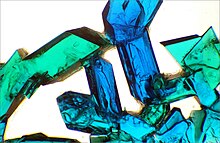Copper (II) acetate
| Structural formula | ||||||||||
|---|---|---|---|---|---|---|---|---|---|---|

|
||||||||||
| General | ||||||||||
| Surname | Copper (II) acetate | |||||||||
| other names |
|
|||||||||
| Molecular formula | C 4 H 6 CuO 4 | |||||||||
| Brief description |
green (anhydrous) to blue-green (monohydrate), odorless crystals |
|||||||||
| External identifiers / databases | ||||||||||
|
||||||||||
| properties | ||||||||||
| Molar mass | 181.64 g mol −1 (anhydrous)
199.64 g mol −1 (monohydrate) |
|||||||||
| Physical state |
firmly |
|||||||||
| density |
1.88 g cm −3 (monohydrate) |
|||||||||
| Melting point |
115 ° C (monohydrate) |
|||||||||
| boiling point |
decomposition |
|||||||||
| solubility |
moderate in water (72 g l −1 at 20 ° C, monohydrate) |
|||||||||
| safety instructions | ||||||||||
|
||||||||||
| MAK |
0.1 mg m −3 |
|||||||||
| Toxicological data | ||||||||||
| As far as possible and customary, SI units are used. Unless otherwise noted, the data given apply to standard conditions . | ||||||||||
Copper (II) acetate (also verdigris ; latin aceticum Cuprum or aerugo ) is a copper salt of acetic acid with the structural formula Cu (CH 3 COO) 2 .
The term "verdigris" (late Middle High German spāngrüen or grüenspān ) after the medieval Latin viride Hispanum ( "Spanish Green") formed because the dye obtained from artificially made acetate of copper oxide in the Middle Ages in Spain was introduced.
properties

Copper (II) acetate crystallizes from aqueous solution as a monohydrate (Cu (CH 3 COO) 2 · H 2 O). The salt forms dark green crystals which dissolve in water (at 20 ° C to 72 g / l) and in ethanol . The crystals weather in air and loose when heated to above 100 ° C its water of crystallization . From 220 ° C the salt decomposes, with copper (I) oxide , copper (II) oxide , acetone , acetaldehyde , carbon monoxide and carbon dioxide being formed as decomposition products.
Manufacturing
Copper acetate is created in the laboratory when copper sheet or wire is placed in acetic acid or vinegar in the air. So-called verdigris is initially formed , which is a mixture of different basic copper acetates and forms at copper points that are above the acetic acid solution. Verdigris is therefore also formed when food containing vinegar is stored in copper vessels. Verdigris (approximate composition Cu (CH 3 COO) 2 · [Cu (OH) 2 ] 3 · 2H 2 O) should not be confused with the green layers of a patina , namely copper (carbonate sulfate chloride) - hydroxide mixtures (basic copper compounds), z. B. form on copper roofs.
Dissolved in acetic acid, verdigris then provides the copper acetate (formerly also called copper smoke ). In the industrial production of copper acetate with acetic acid , copper (II) oxide or basic copper carbonate (CuCO 3 · Cu (OH) 2 ) is used instead of copper metal .
use
Copper acetate is a color pigment (Spanish green) in the colors green (also verdigris) to blue (mixed with lime and acetic acid, copper-calcium acetate is formed). In oil painting it was used, especially during the Renaissance, as one of the few green pigments available at the time. It is an important intermediate product in the production of the poisonous color pigment Schweinfurt Green , serves as a fungicide (anti-fungal agent) and is moderately toxic. In the Bengali light and in fireworks it provides a green flame color.
Occurrence
In nature, copper acetate occurs as the very rare mineral hoganite .
Web links
- ColourLex: Verdigris
Individual evidence
- ↑ The Color of Art Pigment Database: Pigment Green: PG20 artiscreation.com , David Myers. Retrieved July 23, 2016.
- ↑ a b c d e f g h i j Entry on copper (II) acetate in the GESTIS substance database of the IFA , accessed on January 8, 2018(JavaScript required) .
- ↑ Jürgen Martin: The 'Ulmer Wundarznei'. Introduction - Text - Glossary on a monument to German specialist prose from the 15th century. Königshausen & Neumann, Würzburg 1991 (= Würzburg medical-historical research. Volume 52), ISBN 3-88479-801-4 (also medical dissertation Würzburg 1990), p. 135 ( Grüenspān ) and 173 ( Spāngrüen : Grünspan, basic copper acetate Cu (OH ) 2 · (CH 3 COO) 2Cu.)
- ↑ Wolfgang Pfeifer : Etymological Dictionary of German. Akademie, Berlin 1989 (and later editions), s. v .; Smart. Etymological dictionary of the German language . 25th ed., Edit. by Elmar Seebold . De Gruyter, Berlin 2011, p. v.
- ↑ Dieter Lehmann: Two medical prescription books of the 15th century from the Upper Rhine. Part I: Text and Glossary. Horst Wellm, Pattensen / Han. 1985, now at Königshausen & Neumann, Würzburg (= Würzburg medical-historical research , 34), ISBN 3-921456-63-0 , p. 186.
- ↑ Mansour, SAA: Themoanalytical investigations of the decomposition course of copper oxysalts III: Copper (II) acetate monohydrate in J. Therm. Anal. 46 (1996) 263-274, doi : 10.1007 / BF01979966 .
- ^ Wolfgang Schneider: Pharmaceutical chemicals and minerals. Supplements (to Volume III of the Lexicon for the History of Medicines). Frankfurt am Main 1975, p. 84.
- ^ Kühn, H., Grünspan and its use in painting , in: Farbe und Lack , 70, 1964, pp. 703–711.

![{\ mathrm {\ \! \ {\ Biggr]} _ {2}}}](https://wikimedia.org/api/rest_v1/media/math/render/svg/574adab1409cb81da6c38bb738ad111e61bbb2d9)







